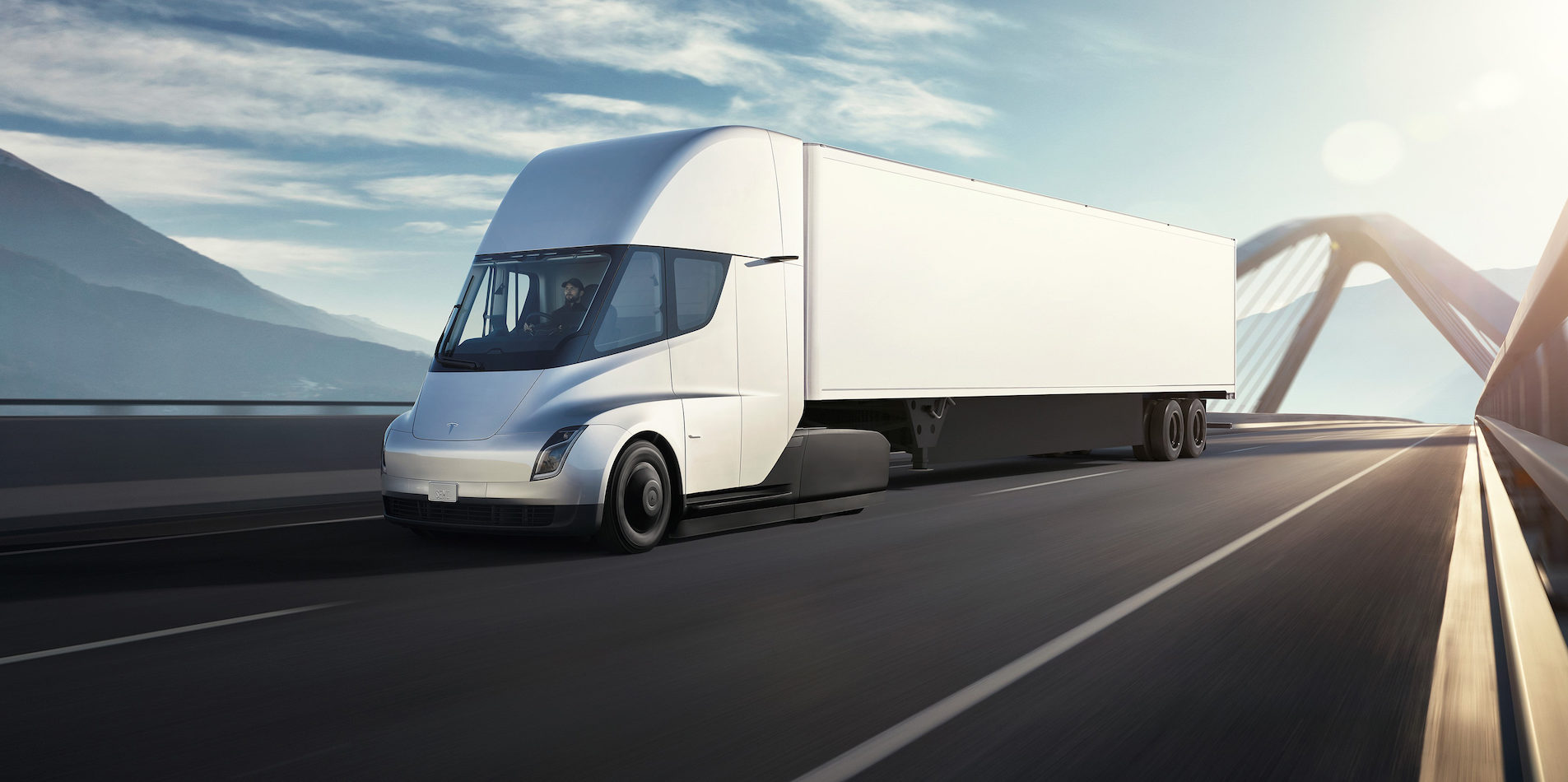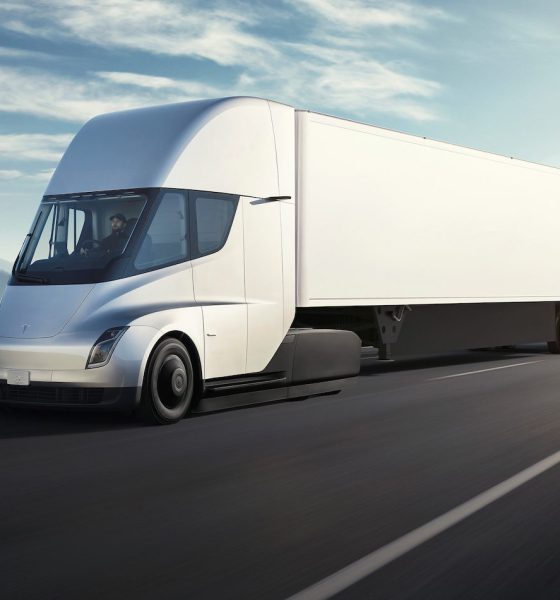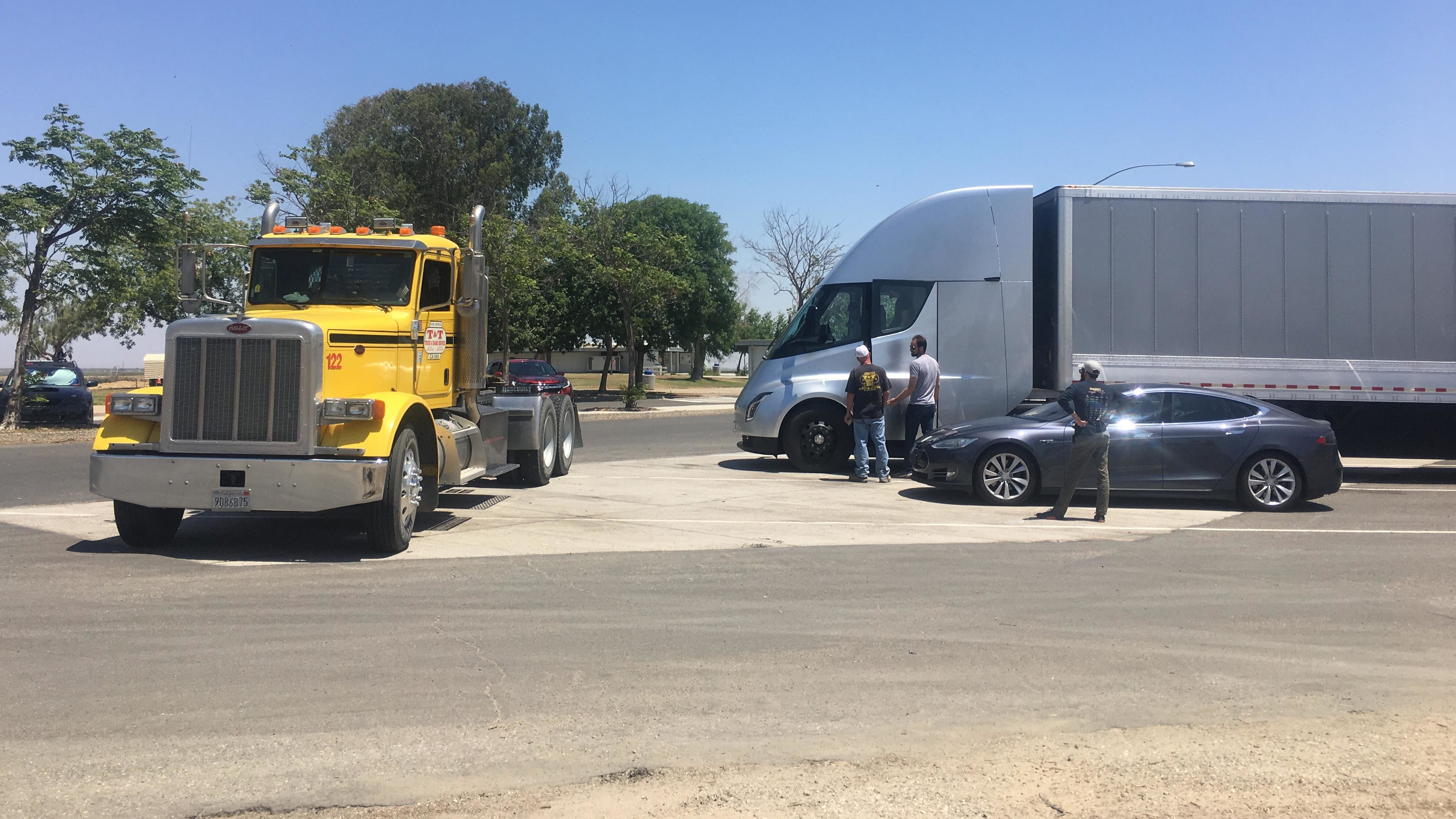

News
Tesla Semi faces new wave of skepticism from diesel veterans
There is very little doubt that the Model S, Model X, and Model 3 have disrupted their respective segments since they were released. Tesla aims to accomplish the same thing with its all-electric Semi truck, but the vehicle’s target is a lot more ambitious — it aims to disrupt the trucking industry.
The trucking industry is vast, and it is still growing. Long-haul trucking stands is the lifeblood of the US economy, handling the transportation of up to 71% of food, retail goods, construction supplies, and other cargo delivered every day. The American Trucking Associations’ American Trucking Trends 2018 report revealed that the US trucking industry generated $700.3 billion in economic activity in 2017, representing a 3.5% increase compared to 2016 when the trucking market generated $676.6 billion. This is the market that Tesla is aiming to tap into with the Semi.
One of the Tesla Semi’s main selling points is that it’s an environmentally-friendly vehicle. Being all-electric, the Semi is a zero-emissions truck. This is an advantage over conventional diesel trucks, which are a significant source of air pollution in the United States. According to the Environmental Protection Agency, greenhouse gases from medium and heavy-duty trucks were found to have increased by 85% between 1990 to 2016, accounting for about 23% of carbon emissions from transportation in 2016. This is despite the fact that diesel engines are getting steadily cleaner. The EPA estimates that emissions from current engines are about 85% lower than before 2007 when the US rolled out new standards.
The Tesla Semi has several features that make it a viable alternative to diesel-powered long-haulers, from its four Model 3-derived electric motors, its comparable Class 8 hauling capacity, and its superior speed. That said, it appears that America’s diesel veterans would not give up without a fight. In a statement to Bloomberg, Jon Mills, a spokesman for engine maker Cummins Inc. noted that electric trucks have a long way to go before they could be considered competition for diesel trucks.
“Right now, we don’t think it’s viable. Electric trucks are more viable where you have shorter routes, less loads and you’re able to recharge,” he said.
Cummins Inc. is one of America’s premier engine-makers, supplying engines for consumer trucks, fire engines, and heavy-duty long-haulers. Most of the company’s engines run on diesel, though they are also making some that operate on natural gas. Mills noted that Cummins is developing electric motors as well, but the company does not expect a lot of demand for them anytime soon.
Mills did admit that electric trucks would contribute to reducing pollution. Nevertheless, the Cummins Inc. spokesman noted that the trucking industry is likely not ready to switch to electric, mainly since vehicles like the Tesla Semi have limited range. Considering that some truck drivers are paid by the mile, they would likely lose money while waiting for their vehicles’ batteries to recharge.
“Diesel will be the primary option for heavy duty trucking markets, long haul especially, for a decade or more,” Mills said.

Elon Musk wants to initiate the transition sooner. When unveiling the Tesla Semi’s specs, Musk noted that the electric long-hauler would be cheaper to operate than comparable diesel-powered trucks. Musk noted that the Semi could cost operators $1.26 per mile to run, less than the standard $1.51 per mile that diesel-powered vehicles cost. That said, Allen Schaeffer, executive director of the Diesel Technology Forum trade group, is skeptical of Musk’s claims, noting that there is little need for a new entrant in the shipping industry.
“It’s easy if you’re just coming into this market to say ‘they’re $1.50 per mile and we can do it for $1.20. But where’s the proof? I haven’t seen it. Diesel is the benchmark for energy efficiency. Diesel dominates the entire sector,” he said.
Amidst continued reservations from veterans in the trucking industry, Tesla is nonetheless pushing through with further development of the Semi. The company has been conducting real-world tests of the Semi since the vehicle was unveiled, and during the Q2 2018 earnings call, Elon Musk noted that improvements to the truck are being made. Thus, when the Tesla Semi enters production, the long-hauler would be an even more viable alternative to diesel-powered trucks.
“We’ve made significant improvements to the design since the unveiling that we had, and it’s really even better than what we talked about,” Musk said.

News
Elon Musk’s Grok AI to be used in U.S. War Department’s bespoke AI platform
The partnership aims to provide advanced capabilities to 3 million military and civilian personnel.

The U.S. Department of War announced Monday an agreement with Elon Musk’s xAI to embed the company’s frontier artificial intelligence systems, powered by the Grok family of models, into the department’s bespoke AI platform GenAI.mil.
The partnership aims to provide advanced capabilities to 3 million military and civilian personnel, with initial deployment targeted for early 2026 at Impact Level 5 (IL5) for secure handling of Controlled Unclassified Information.
xAI Integration
As noted by the War Department’s press release, GenAI.mil, its bespoke AI platform, will gain xAI for the Government’s suite of tools, which enable real-time global insights from the X platform for “decisive information advantage.” The rollout builds on xAI’s July launch of products for U.S. government customers, including federal, state, local, and national security use cases.
“Targeted for initial deployment in early 2026, this integration will allow all military and civilian personnel to use xAI’s capabilities at Impact Level 5 (IL5), enabling the secure handling of Controlled Unclassified Information (CUI) in daily workflows. Users will also gain access to real‑time global insights from the X platform, providing War Department personnel with a decisive information advantage,” the Department of War wrote in a press release.
Strategic advantages
The deal marks another step in the Department of War’s efforts to use cutting-edge AI in its operations. xAI, for its part, highlighted that its tools can support administrative tasks at the federal, state and local levels, as well as “critical mission use cases” at the front line of military operations.
“The War Department will continue scaling an AI ecosystem built for speed, security, and decision superiority. Newly IL5-certified capabilities will empower every aspect of the Department’s workforce, turning AI into a daily operational asset. This announcement marks another milestone in America’s AI revolution, and the War Department is driving that momentum forward,” the War Department noted.
News
Tesla FSD (Supervised) v14.2.2 starts rolling out
The update focuses on smoother real-world performance, better obstacle awareness, and precise end-of-trip routing, among other improvements.

Tesla has started rolling out Full Self-Driving (Supervised) v14.2.2, bringing further refinements to its most advanced driver-assist system. The new FSD update focuses on smoother real-world performance, better obstacle awareness, and precise end-of-trip routing, among other improvements.
Key FSD v14.2.2 improvements
As noted by Not a Tesla App, FSD v14.2.2 upgrades the vision encoder neural network with higher resolution features, enhancing detection of emergency vehicles, road obstacles, and human gestures. New Arrival Options let users select preferred drop-off styles, such as Parking Lot, Street, Driveway, Parking Garage, or Curbside, with the navigation pin automatically adjusting to the user’s ideal spot for precision.
Other additions include pulling over for emergency vehicles, real-time vision-based detours for blocked roads, improved gate and debris handling, and extreme Speed Profiles for customized driving styles. Reliability gains cover fault recovery, residue alerts on the windshield, and automatic narrow-field camera washing for new 2026 Model Y units.
FSD v14.2.2 also boosts unprotected turns, lane changes, cut-ins, and school bus scenarios, among other things. Tesla also noted that users’ FSD statistics will be saved under Controls > Autopilot, which should help drivers easily view how much they are using FSD in their daily drives.
Key FSD v14.2.2 release notes
Full Self-Driving (Supervised) v14.2.2 includes:
- Upgraded the neural network vision encoder, leveraging higher resolution features to further improve scenarios like handling emergency vehicles, obstacles on the road, and human gestures.
- Added Arrival Options for you to select where FSD should park: in a Parking Lot, on the Street, in a Driveway, in a Parking Garage, or at the Curbside.
- Added handling to pull over or yield for emergency vehicles (e.g. police cars, fire trucks, ambulances).
- Added navigation and routing into the vision-based neural network for real-time handling of blocked roads and detours.
- Added additional Speed Profile to further customize driving style preference.
- Improved handling for static and dynamic gates.
- Improved offsetting for road debris (e.g. tires, tree branches, boxes).
- Improve handling of several scenarios, including unprotected turns, lane changes, vehicle cut-ins, and school buses.
- Improved FSD’s ability to manage system faults and recover smoothly from degraded operation for enhanced reliability.
- Added alerting for residue build-up on interior windshield that may impact front camera visibility. If affected, visit Service for cleaning!
- Added automatic narrow field washing to provide rapid and efficient front camera self-cleaning, and optimize aerodynamics wash at higher vehicle speed.
- Camera visibility can lead to increased attention monitoring sensitivity.
Upcoming Improvements:
- Overall smoothness and sentience.
- Parking spot selection and parking quality.
News
Tesla is not sparing any expense in ensuring the Cybercab is safe
Images shared by the longtime watcher showed 16 Cybercab prototypes parked near Giga Texas’ dedicated crash test facility.

The Tesla Cybercab could very well be the safest taxi on the road when it is released and deployed for public use. This was, at least, hinted at by the intensive safety tests that Tesla seems to be putting the autonomous two-seater through at its Giga Texas crash test facility.
Intensive crash tests
As per recent images from longtime Giga Texas watcher and drone operator Joe Tegtmeyer, Tesla seems to be very busy crash testing Cybercab units. Images shared by the longtime watcher showed 16 Cybercab prototypes parked near Giga Texas’ dedicated crash test facility just before the holidays.
Tegtmeyer’s aerial photos showed the prototypes clustered outside the factory’s testing building. Some uncovered Cybercabs showed notable damage and one even had its airbags engaged. With Cybercab production expected to start in about 130 days, it appears that Tesla is very busy ensuring that its autonomous two-seater ends up becoming the safest taxi on public roads.
Prioritizing safety
With no human driver controls, the Cybercab demands exceptional active and passive safety systems to protect occupants in any scenario. Considering Tesla’s reputation, it is then understandable that the company seems to be sparing no expense in ensuring that the Cybercab is as safe as possible.
Tesla’s focus on safety was recently highlighted when the Cybertruck achieved a Top Safety Pick+ rating from the Insurance Institute for Highway Safety (IIHS). This was a notable victory for the Cybertruck as critics have long claimed that the vehicle will be one of, if not the, most unsafe truck on the road due to its appearance. The vehicle’s Top Safety Pick+ rating, if any, simply proved that Tesla never neglects to make its cars as safe as possible, and that definitely includes the Cybercab.








